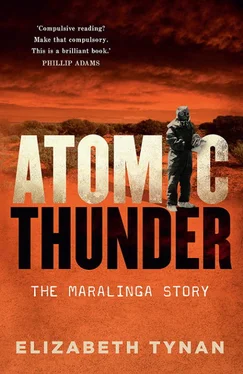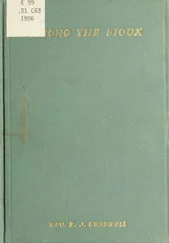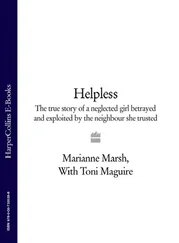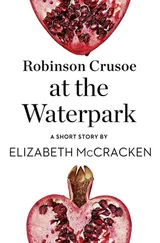Rats and Tims were held at Maralinga. The Rats experiments measured how materials were compressed under the high pressure inside a nuclear warhead when it was detonated. Tims was similar to Rats but used a different measurement method. In the Tims experiments, one of the materials measured was plutonium, so Tims left more significant contamination.
They were initially called minor trials, and this was followed by other innocuous names – in 1959 there were ‘assessment tests’ and from January 1960 the Maralinga Experimental Programme, often abbreviated to MEP. Justice James McClelland commented on the ‘almost comical touch of camouflage in the changes of name of the minor trials’, especially given the ban on nuclear tests being negotiated at the time.
Vixen B investigated questions about safety of storage and transportation of nuclear material. How would bombs and related paraphernalia behave if, for example, a plane laden with nuclear warheads crashed on take-off? The ‘broken arrow’ scenario – ‘an unexpected event involving nuclear weapons that results in the accidental launching, firing, detonating, theft or loss of the weapon’ – loomed large after several crashes of aircraft carrying atomic weaponry. Since 1950, a large (and mostly secret) array of accidents involving nuclear weaponry had occurred, sparking fears of a nuclear catastrophe caused by accident or terrorism.
When Vixen B was first planned in 1958, Britain had undertaken six years of atomic weaponry testing, and its nuclear arsenal was sufficiently advanced to go into operational deployment. Blue Danube was a tactical nuclear weapon (soon to be replaced by the smaller Red Beard), deployed to the RAF. When the Vixen B series began in 1960, Britain had rejoined the newly amenable Americans and, among other things, embarked upon a series of similar tests. The US Roller Coaster tests, which examined environmental dispersal of plutonium, had slightly narrower objectives to Vixen B, but similar methods. The Vixen B tests in Australia explicitly addressed the broken arrow scenario in addition to plutonium dispersal. Some people also suspected that Vixen B was more than just a safety test series. According to nuclear engineer Alan Parkinson, ‘While they were said to be to test the safety of nuclear weapons in storage or transit, there was also an element of weapons development in these trials’. The data from Vixen B are still retained by the UK Ministry of Defence, long after the 30-year rule, meaning no-one is entirely sure exactly what they found or how it was used for weapons development.
The 12 Vixen B experiments at Taranaki between 1960 and 1963 involved blowing up plutonium-239 with conventional explosives. Nuclear warheads were strapped on feather beds 2 metres above the ground and subjected to so-called one-point safety trials. This meant detonating one point in a matrix of, say, 32 points of high explosive that must all explode in a rapid sequence to ignite an atomic blast. The plutonium was contained within the bundle of explosives. When the explosive was detonated, the plutonium was compressed and became molten. Plutonium is pyrophoric – it burns on contact with air – and when blown up it produced an aerosol of plutonium oxide particles that spread out from the Taranaki site. Narrow plumes of plutonium aerosol stretched many kilometres out in a hand-like shape over the northwest to northeast. The one-point trials were intended to show that igniting one point in the matrix would not set off the nuclear fission of an atomic blast and apparently succeeded in doing so, at least for low-yield weaponry.
This form of experiment was dangerous, as the British acknowledged in their secret correspondence. AWRE safety co-ordinator Roy Pilgrim noted in a memorandum ‘the potential catastrophic nature of a mistake’ and urged ‘rigid adherence to the planned procedure’. The tests were not intended to produce nuclear reactions, but, in the event, as secretly predicted by the British, fission and fusion reactions did occur. Indeed, Pilgrim discussed fission openly with Ernest Titterton in a letter of October 1962, saying, ‘Whereas for previous Vixen B firings the experiments were so designed that fission products could not be present in quantities sufficient to add a radiotoxic effect… we are now seeking greater flexibility in the design of the experiments and to achieve this we need the freedom to plan in such a way that fission products may be generated’.
While the Vixen B test series used most of the plutonium-239 that contaminated Maralinga, various isotopes of plutonium were used extensively in other minor trials too. In one Tims trial, half a kilogram of weapons-grade plutonium was fired into a pad filled with salt, and six drums containing the contaminated salt were then buried at the Maralinga airport cemetery. This plutonium was mostly plutonium-239, along with some shorter lived isotopes – plutonium-240 and a tiny amount of plutonium-241. The plutonium from this test became the centre of a media controversy in 1978 when a secret Cabinet submission revealing the burial site was leaked to journalist Brian Toohey (see chapter 10). It was repatriated to Britain in 1979, the only loose plutonium from Maralinga to be recovered.
These high explosive tests ceased in 1963 when both Britain and Australia became signatories to the United Nations Partial Test Ban Treaty that outlawed atmospheric testing. The official name for the partial test ban treaty was Treaty Banning Nuclear Weapons Tests in the Atmosphere, in Outer Space and Under Water. It was signed in Moscow on 5 August 1963. An earlier moratorium on nuclear weapons testing, from 1958 to 1961, may have been knowingly subverted by the British test authorities in the case of the Vixen B tests, largely through the use of innocuous names (‘minor trials’, ‘assessment tests’), and without telling the Australian Government exactly what the tests involved. John Moroney wrote later:
Both [the UK and US] believed that these [one-point] studies were not nuclear weapons tests within the terms of the moratorium, but they were anxious not to be seen to be infringing the terms in any way. Accordingly, they performed the tests on reduced assemblies of the fission triggers to ensure that any nuclear yield was small, and conducted them under tight security, away from prying eyes.
As a direct result of the Vixen B tests, the feather beds, and lots of other equipment and buildings in the area, became impregnated with the most dangerous plutonium isotope, plutonium-239. The explosions created a kind of ‘dirty bomb’, releasing significant quantities of radioactive material into the atmosphere and subsequently onto the ground. In a submission to the Royal Commission, the ARL (now ARPANSA) ‘estimated that there were between 25 000 and 50 000 plutonium-contaminated fragments in the Taranaki area, although the number might need to be doubled if missed and buried fragments were included… The finding of this large number of plutonium-contaminated fragments was a surprise and changed the whole concept of hazard assessment of the plutonium-contaminated areas’. Over time, this calculation was revised to three million fragments. Staging the Vixen B trials cost Australia a lot of money – the cost for the first series alone was over £25 000 in labour, materials, plant hire and other expenses. It reaped three million loose fragments of plutonium.
Small particles of plutonium can be picked up readily in dust and can swirl around the landscape. Anyone in the vicinity might breathe it in. It is an insoluble particle that, if inhaled, lodges in the lungs, where it can stay throughout a person’s lifetime and irradiate its surroundings, possibly causing lung cancer. The risk is precisely proportional to the dose. If a person breathes in enough plutonium-239 to receive a dose of 1 millisievert (a unit of biological absorption of ionising radiation) the risk that he or she will get lung cancer is about one in 20 000. If a person ingests or inhales enough to receive a dose of 100 millisieverts then the risk is one in 200.
Читать дальше












